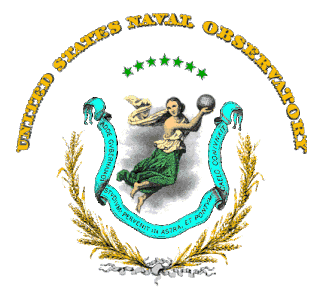
The United States Naval Observatory (USNO) is a scientific and military facility that produces geopositioning, navigation and timekeeping data for the United States Navy and the United States Department of Defense. Established in 1830 as the Depot of Charts and Instruments, it is one of the oldest scientific agencies in the United States, and remains the country's leading authority for astronomical and timing data for all purposes.

Armagh Observatory is an astronomical research institute in Armagh, Northern Ireland. Around 25 astronomers are based at the observatory, studying stellar astrophysics, the Sun, Solar System astronomy and Earth's climate.
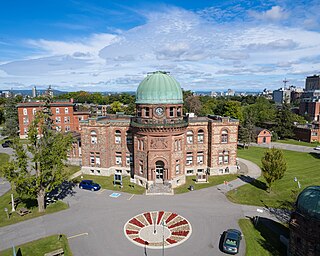
The Dominion Observatory was an astronomical observatory in Ottawa, Ontario that operated from 1902 to 1970. The Observatory was also an institution within the Canadian Federal Government. The observatory grew out of the Department of the Interior's need for the precise coordinates and timekeeping that at that time could only come from an observatory. For several years they had used a small observatory on the Ottawa River for this purpose. In 1902, it was decided that Canada needed a larger national observatory similar to the Royal Greenwich Observatory in Britain.

South African Astronomical Observatory (SAAO) is the national centre for optical and infrared astronomy in South Africa. It was established in 1972. The observatory is run by the National Research Foundation of South Africa. The facility's function is to conduct research in astronomy and astrophysics. The primary telescopes are located in Sutherland, which is 370 kilometres (230 mi) from Observatory, Cape Town, where the headquarters is located.
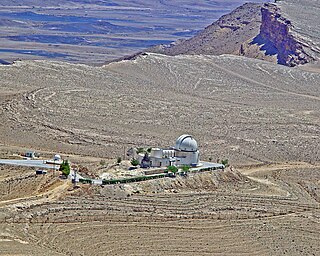
The Florence and George Wise Observatory is an astronomical observatory owned and operated by Tel Aviv University. It is located 5 kilometers west of the town of Mitzpe Ramon in the Negev desert near the edge of the Ramon Crater, and it is the only professional astronomical observatory in Israel.

The Kodaikanal Solar Observatory is a solar observatory owned and operated by the Indian Institute of Astrophysics. It is on the southern tip of the Palani Hills 4 kilometres (2.5 mi) from Kodaikanal.

The Astronomical Observatory of Capodimonte is the Neapolitan department of Istituto Nazionale di Astrofisica, the most important Italian institution promoting, developing and conducting scientific research in the fields of astronomy, astrophysics, and space science.

The Brera Observatory is an astronomical observatory in the Brera district of Milan, Italy. It was built in the historic Palazzo Brera in 1764 by the Jesuit astronomer Roger Boscovich. Following the suppression of the Jesuits by Clement XIV on 21 July 1773, the palace and the observatory passed to the then rulers of northern Italy, the Austrian Habsburg dynasty.

The Royal Observatory of Belgium, has been situated in the Uccle municipality of Brussels, Belgium, since 1890. It was first established in Saint-Josse-ten-Noode in 1826 by King William I of the Netherlands under the impulse of Adolphe Quetelet. It was home to a 100 cm (39 in) diameter aperture Zeiss reflector in the first half of the 20th century, one of the largest telescopes in the world at the time. It now owns a variety of other astronomical instruments, such as astrographs, as well as a range of seismograph equipment.

The National Observatory of Athens is a research institute in Athens, Greece. Founded in 1842, it is the oldest research foundation in Greece. The Observatory was the first scientific research institute built after Greece became independent in 1829, and one of the oldest research institutes in Southern Europe. It was built around the same period as the United States Naval Observatory.
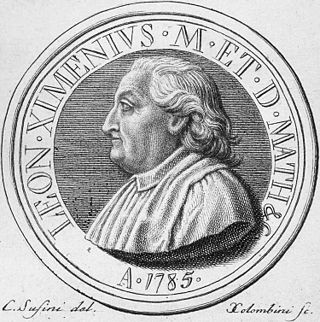
Leonardo Ximenes was a famous Italian Jesuit mathematician, engineer, astronomer and geographer from Sicily.

Alessandro Serpieri was an Italian scientist known for work in astronomy and seismology.

The Republic Hydrometeorological Institute of Serbia is the national meteorological and hydrological service of Serbia.

The Gregorian Tower or Tower of the Winds is a square tower and early modern observatory located above the Gallery of Maps, which connects the Villa Belvedere with the Apostolic Palace in Vatican City. The tower was built between 1578 and 1580 to a design by the Bolognese architect Ottaviano Mascherino mainly to promote the study of astronomy for the Gregorian Calendar Reform which was commissioned by Pope Gregory XIII and promulgated in 1582. It was then also known as the Tower of Winds. The tower was also called "Specola Astronomica Vaticana", a reference to the Vatican Observatory. Four stages of progressive development have occurred since it was first established. The tower was an edifice of great value for astronomical observations made using a sundial as they provided essential confirmation of the need to reform the Julian calendar.
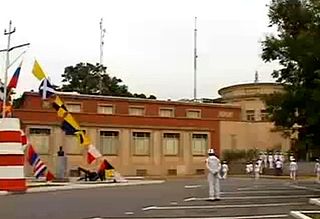
The Astronomical and Meteorological Observatory of Caracas, was created by decree of President Juan Pablo Rojas Paul on September 8, 1888. The observatory was established on Quintana Hill, later changed to Cagigal Hill in honor of the astronomer and mathematician, Colonel Juan Manuel Cagigal, who was the founder of mathematical studies in Venezuela. The hill is also known as Observatory Hill.

The National Observatory is an institution localized in Rio de Janeiro, Brazil. Founded by Pedro I on October 15, 1827, it is one of the oldest scientific institutions in the country. Its initial purpose was to guide the geographic studies of Brazil and teaching navigation.

Belgrade Observatory is an astronomical observatory located in the eastern part of Belgrade, Serbia, in the natural environment of Zvezdara Forest.

The Giuseppe S. Vaiana Astronomical Observatory is an astronomical observatory located in Palermo, Sicily, Italy, housed inside the Palazzo dei Normanni. It is one of the research facilities of the National Institute of Astrophysics. The observatory carries out research projects in the field of astronomy and astrophysics including the study of solar and stellar coronas, stellar evolution and of the supernova remnants.

Milan G. Nedeljković was the first modern professor of astronomy and meteorology at the Grandes écoles, and the founder and first director of the Astronomical and Meteorological Observatory in Belgrade.

The former Collegio degli Scolopi is a large building in Florence, annexed to the church of San Giovanni degli Scolopi and located between via de 'Martelli, via dei Gori, Piazza San Lorenzo and Borgo San Lorenzo. Formerly the palace of the Martelli family, it was the seat of the Jesuit order, designed on a grand scale by Bartolomeo Ammannati, then housed the college of the Piarists and finally, after the suppression of the convents, it became a school. Today most of its rooms are occupied by the Galileo state classical high school, but in one part there is also the Ximenian observatory, with access from the rear Borgo San Lorenzo.






















